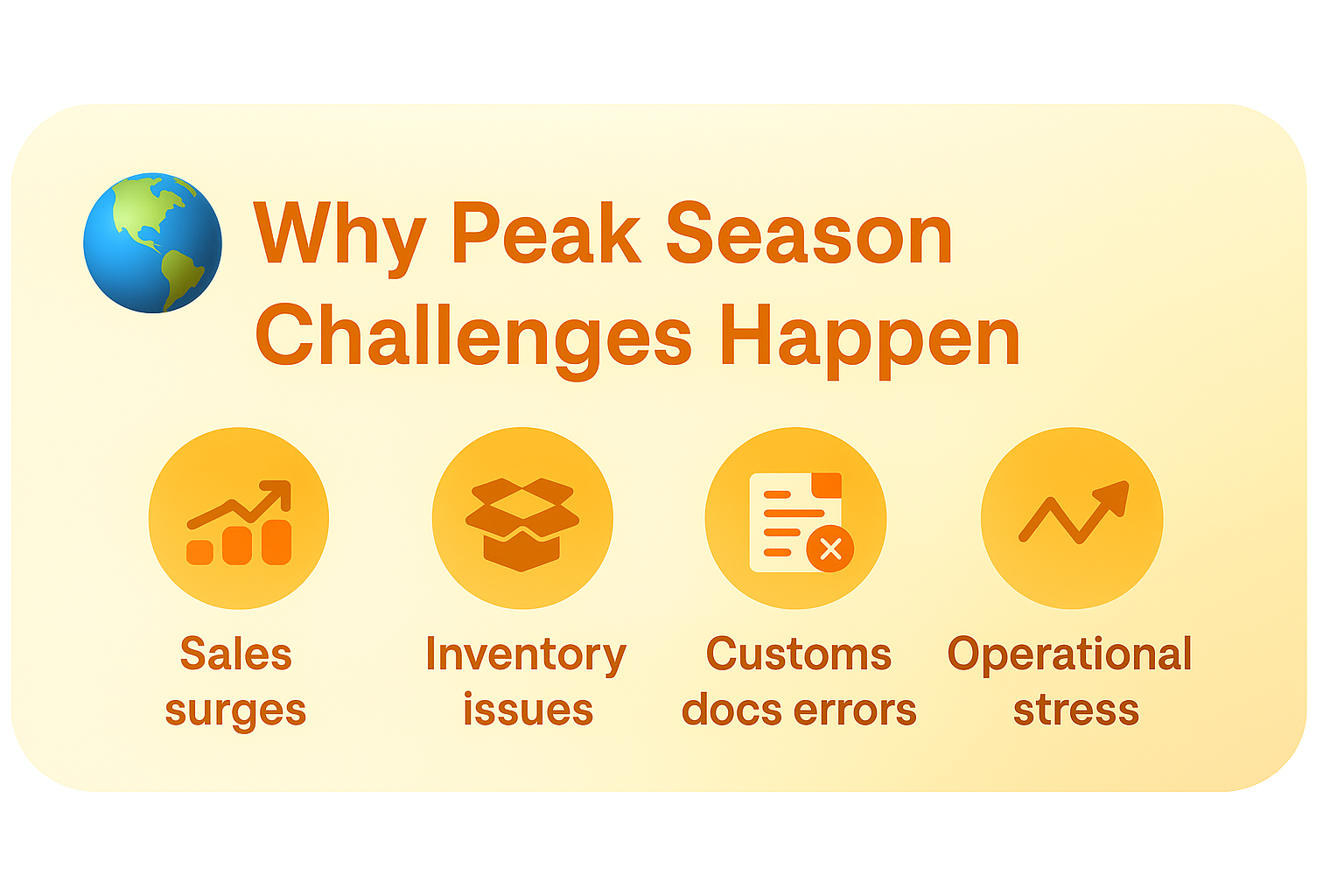For exporters, the peak season can be both exciting and exhausting. Whether it is about selling your products during the Black Friday sale or the coming Christmas season. The surge in sales during this season or the global demand brings growth opportunities for all the exporters. But it also exposes weaknesses in planning, logistics, and coordination of the exporters.

During these times, exporter challenges in high-volume shipping often skyrocket. Inventory runs out faster, documentation errors increase, and shipments get delayed at customs, all because of multiple orders that need to be delivered. The pressure to move goods quickly can lead to common export errors (which are common) and fixes being overlooked.
Whether you’re a growing SME or a seasoned exporter, understanding these pitfalls can help you avoid delays in international shipping and deliver consistent service. In this blog, we’ll explore the five most frequent export mistakes during peak season, their impact, and proven ways to overcome them.
1. Poor Inventory Management and Forecasting
📦 Poor Inventory Management & Forecasting
Mistake You Make: Exporters often fail to plan inventory for high-demand seasons, leading to overstocking or understocking.
Why It Happens: Lack of past sales analysis, poor forecasting, and supplier delays during peak demand.
Impact: Missed sales, order cancellations, higher storage costs, and reduced profit margins.
How to Fix It: Study last year’s data, maintain safety stock, confirm supplier lead times early, and use logistics or inventory tools for better control.
💡 Pro Tip: Strong inventory planning minimizes chaos and keeps exports smooth during busy seasons.
Mistake You Make
The major issue is that when demand spikes during the sales season, many exporters struggle to understand how much stock they actually need.
When you make inventory management errors, you know what happens? They usually result in either overstocking (which impacts your funds) or understocking (which leads to missed sales).
When sale season starts and exporters do high-volume export, controlling your inventory becomes harder because supply chains tighten and suppliers may not fulfil sudden bulk orders on time. When you plan poorly, that can turn profitable opportunities into operational chaos.
Its Impact
Running out of stock mid-season can cause order cancellations and missed delivery deadlines. On the other hand, overstocking raises warehousing and handling costs, eating into your margins.
How to Fix It
- Study first: Understand previous years’ data and do not repeat those mistakes.
- Maintain “extra stock” or “safety stock” for your most popular products.
- For e-commerce specifically, “integrate” with your logistics platform for high-volume export management.
- Review supplier contracts early and confirm lead times well before the peak period.
- Strong inventory planning isn’t just about counting cartons – it’s about minimising export logistics problems before they happen.
2. Incomplete or Incorrect Customs Documentation
🧾 Incomplete or Incorrect Customs Documentation
Mistake You Make: Exporters rush through paperwork and skip verifying invoices, packing lists, and declarations.
Why It Happens: Pressure from multiple shipments and lack of a proper documentation checklist.
Impact: Customs delays, penalties, shipment returns, and unhappy buyers.
How to Fix It: Double-check all documents, use digital templates, update checklists by country, and work with logistics experts to ensure compliance.
💡 Pro Tip: Accurate documentation keeps your shipments moving and prevents customs issues during peak rush.
Mistake You Make
This is a big mistake that majorly beginner make, but we are all human. So the biggest export mistakes during peak season are rushing through paperwork. Usually, when shipments start piling up, exporters often skip cross-checking invoices, packing lists, or declarations. These are some major customs documentation in which mistakes can lead to serious delays at international borders.
Its Impact
Small things matter – even a small mistake in an HS code or value declaration can trigger customs holds, penalties, or shipment returns. You know its result? Unhappy customers and unexpected costs that end up affecting your image.
How to Fix It
- Double-check every document before submission – especially export invoices and airway bills.
- Use digital templates to minimise manual entry errors.
- Partner with logistics providers experienced in risk mitigation in export logistics who can help you prepare compliant paperwork.
- Update your checklist: Always remember to update your checklist of export documents required for each and every destination country you are exporting into.
Accurate documentation: Every exporter should know about this one good practice to be a successful exporter, and that is accurate documentation. It keeps your shipments moving and prevents last-minute stress when demand peaks.
3. Choosing the Wrong Shipping Partner
🚚 Choosing the Wrong Shipping Partner
Mistake You Make: Selecting couriers based only on price, not reliability or capacity.
Why It Happens: Focus on short-term savings without checking courier service quality and support strength.
Impact: Delays, missed deadlines, poor customer experience, and damaged reputation.
How to Fix It: Compare couriers by delivery success rate, choose logistics partners experienced in high-volume export, and always keep a backup option ready.
💡 Pro Tip: A good logistics partner ensures timely deliveries, happy customers, and stress-free scaling.
Mistake You Make
Never choose carriers based purely on cost (NEVER). The exporter might think this is a smart step but this can backfire. A cheap courier without strong capacity or customer support can easily become a bottleneck.
Mostly many exporters overlook these export logistics problems. Later on, this directly leads to missed delivery deadlines and poor buyer experiences.
Its Impact
This might be exporters’ deadly nightmare, imagine your parcels might sit in warehouses or ports for days, while customers keep asking for updates. Imagine what will happen when your product gets delivered “LATE.” This will definately damage your reputation, especially during high-demand periods when buyers.
How to Fix It
- Don’t just see cost; always start by evaluating couriers based on timely delivery rates.
- Choose logistic partners that specialise in high-volume export management and know how to handle volume effectively.
- Use platforms that offer transparent tracking and dedicated support for exporters 24/7.
- Be ready with option 2 – have a backup courier ready in case your primary carrier faces congestion.
Ensure you make a smart logistics choice to avoid delays in international shipping, maintain consistency, and scale your operations seamlessly during peak periods.
4. Wrong Packaging, Labelling, and Bad Tracking Systems
🎁 Bad Packaging, Labelling & Tracking Systems
Mistake You Make: Poor packaging, unclear labels, or missing tracking info causing confusion and delays.
Why It Happens: Rushed packaging and lack of standard packing procedures during peak season.
Impact: Returns, rejections, damaged parcels, refund requests, and frustrated customers.
How to Fix It: Follow international packaging standards, label boxes with correct product info and origin, use barcodes, and ensure real-time tracking.
💡 Pro Tip: Good packaging is not just protection — it reflects your professionalism and builds buyer confidence.
Mistake You Make
Imagine your customer opening absolutely poor packed box or your parcel getting stuck in custom because of unclear labelling. Sounds harsh right but in reality these are classic export mistakes that exporters make during peak sale season.
Rushed packing, missing labels, or wrong product details can create confusion at customs and during last-mile delivery which will eventually cause delivery issues for you.
Its Impact
- When you do poor packaging and unclear labelling it will lead to shipment returns or rejections.
- Imagine your customer getting infuriated because they can’t track their shipment.
- Damaged parcels or incorrect addresses can cause delays and refund requests.
How to Fix It
When you have fragile or regulated goods, follow international packaging standards.
Product codes, country of origin, and tracking details; label all boxes clearly.
5. Poor Communication and No Backup Plan
💬 Poor Communication & No Backup Plan
Mistake You Make: Stopping proactive communication during busy periods and not preparing backup options.
Why It Happens: Overload of orders and weak coordination among teams.
Impact: Buyers lose trust, refunds increase, and operations become chaotic.
How to Fix It: Keep buyers updated in real time, automate alerts, document a communication plan, and always have alternate couriers ready.
💡 Pro Tip: Clear communication and contingency planning maintain trust and stability during peak export season.
Mistake You Make
Never stop your communication channel with your customers, whether it is through social pages or any other. Why? Because when rush periods begin, exporters often stop communicating proactively. When shipments are delayed or rerouted, customers are left in the dark. This lack of communication – combined with no contingency plan – can ruin relationships and lead to missed delivery deadlines.
Its Impact
- Buyers lose confidence and switch to competitors.
- Refunds increase, and reputation suffers.
- Operational teams face pressure without clear visibility into next steps.
How to Fix It
- Keep your buyers informed with real-time shipment updates and expected delivery timelines.
- Use platforms that allow automated notifications for shipment tracking failures or exceptions.
- Prepare contingency routes and backup couriers for emergencies.
- Document your internal communication plan – who updates whom, and how often.
Strong communication is one of the timeless exporter best practices. It not only solves immediate problems but also strengthens long-term client trust.
Conclusion
The above-mentioned export mistakes aren’t unique but some ignored parctice that exporters perform during peak season sale. But what separates successful exporters from the rest is how they respond to these chaotic situations.
By getting over these exporter challenges in high-volume shipping, improving documentation accuracy, and enhancing inventory visibility, you can reduce export logistics problems.
🌍 Key Takeaways for Exporters
- 📦 Plan your inventory early and track movement using smart, data-driven tools.
- 🧾 Double-check all documents to prevent customs delays and compliance mistakes.
- 🚚 Choose logistics partners who can handle high-volume exports efficiently and reliably.
- 🎁 Prioritise packaging and clear labelling to prevent product rejections or returns.
- 💬 Communicate proactively and always keep a solid backup plan ready for peak season.
Key Takeaways:
- Plan your inventory early and track movement using data-driven tools.
- Double-check documents to prevent customs documentation mistakes.
- Choose logistics partners who can handle high-volume export management efficiently.
- Prioritise packaging quality and clear labelling to prevent rejections.
- Communicate proactively and always prepare a backup plan.
Each of these steps builds toward risk mitigation in export logistics, helping you maintain operational stability when demand surges.
If you’re a growing exporter, learn from these common export errors and fixes before your next busy season. By avoiding these pitfalls, you’ll not only meet deadlines but also strengthen your brand’s global reputation.
Pro tip: Simplify your logistics with partners like ShipGlobal, who specialise in international courier solutions, customs support, and automated tracking – helping you avoid delays in international shipping and deliver with confidence every time.







